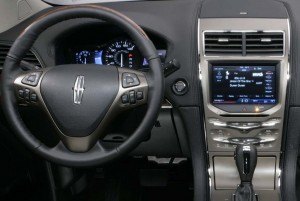
The latest generation of Ford's Sync infotainment system will allow a motorist to access smartphone apps including Pandora, Stitcher and Twitter.
If “electrification” was the hot topic of 2009, this year, the buzzword is “connectivity.” Even as more and more states wrestle with bans on in-car calling and texting, automakers are looking for new ways to keep motorists linked to the outside world.
“People have become addicted to connectivity,” suggests Derrick Kuzak, Ford’s global product development chief.
The Detroit maker took a plunge into the digital pool, several years ago, when it launched its new Sync infotainment system. Developed in cooperation with Microsoft, Sync is a voice-activated package of audio and navigation services that can be voice operated.
But in sharp contrast with General Motors’ OnStar, Sync is a relatively open system – “the electronic equivalent of a Swiss Army Knife,” according to Kuzak — which means it’s easy to update and add features that weren’t necessarily developed by or for Ford.
That point is being underscored, today, at the annual Consumer Electronics Show, or CES, in Las Vegas, where Ford CEO Alan Mulally is serving as keynote speaker. Mulally will unveil the new MyFord system which will make it easy to access a number of smartphone applications, or “apps,” directly through Sync.
The initial three apps are Pandora, a service permitting users to create their own virtual radio stations around a particular artist or music genre, Stitcher, a web service that provides numerous audio news feeds, and the mind-bogglingly popular Twitter. Better yet, they will have the same look and feel when displayed on the Sync LCD monitor as the same apps have on a smartphone like Apple’s iPhone or the Blackberry.
To make it easier to link a phone with Sync, the next-gen MyFord system (and in the maker’s luxury line, MyLincoln) will offer three ways to connect: Bluetooth, a hardwired USB connector or WiFi. The latter could also be used to link the car directly to an outside data source, such as when parked in an owner’s garage.
There are, of course, some drawbacks to using cellphone apps, especially when playing music on a service like Pandora. As the ongoing battle between Verizon and AT&T underscores, cellphone coverage is anything but ubiquitous. Even in major markets, such as Detroit, New York or Los Angeles, there are plenty of places where coverage is spotty or non-existent.
“It’s a problem everyone in the industry is facing when using cellphones,” laments Sync chief Jim Buczkowski.
And it’s a good reason why MyFord will also offer the new HD Radio technology – and the ability to “tag” a song. Like something you hear, simply press a button and you’ll later get a heads-up allowing you to purchase that tune online.
Ford isn’t the only automaker emphasizing connectivity – as GM is quick to point out. Its OnStar service is making news of its own at CES, announcing that buyers of the new Chevrolet Volt plug-in hybrid will be able to do things like monitor the vehicle’s batteries, start the car or unlock its doors by using a specially-developed smartphone app.
Kia, meanwhile, is unveiling a system of its own at CES that’s based on the same Microsoft operating system underlying Ford’s Sync. It will include satellite radio, an onboard “jukebox” system, navigation – and the ability to easily update the system with new features delivered either over the air, through plug-in data transfer or via the Web.
One of the big concerns for the industry is the growing opposition to the use of handheld mobile devices for such things as calling or texting. Most makers, including Ford and GM, have come out in favor of restricting hands-on calling and texting, though they pointedly resist those who would ban even hands-free cellphoning.
“Just talking on a cellphone does not increase the risk of crashing,” argues Ford’s Kuzak.
Of course, the investment in voice-controlled technology would be at risk if even tougher laws were put in place.
Another big question concerns the profit potential of connected technology. OnStar follows a more traditional approach, which is to charge for both hardware and add a monthly or annual service fee. Ford is charging only for the hardware, including service fees in that up-front investment.
Longer-term, acknowledges Kuzak, the automaker will look for other options, and could borrow a page from the Apple playbook. The Silicon Valley firm has made a sizable sum by supplying over a billion app downloads, and countless iTunes music downloads.
The Ford executive tells TheDetroitBureau.com that his company is looking at ways to do a brick-and-mortar version of Apple’s iTunes store, possibly creating dedicated facilities at its U.S. dealerships. It would create an immediate new line of revenue, the company believes, and a way to help drive more traffic into Ford showrooms.
